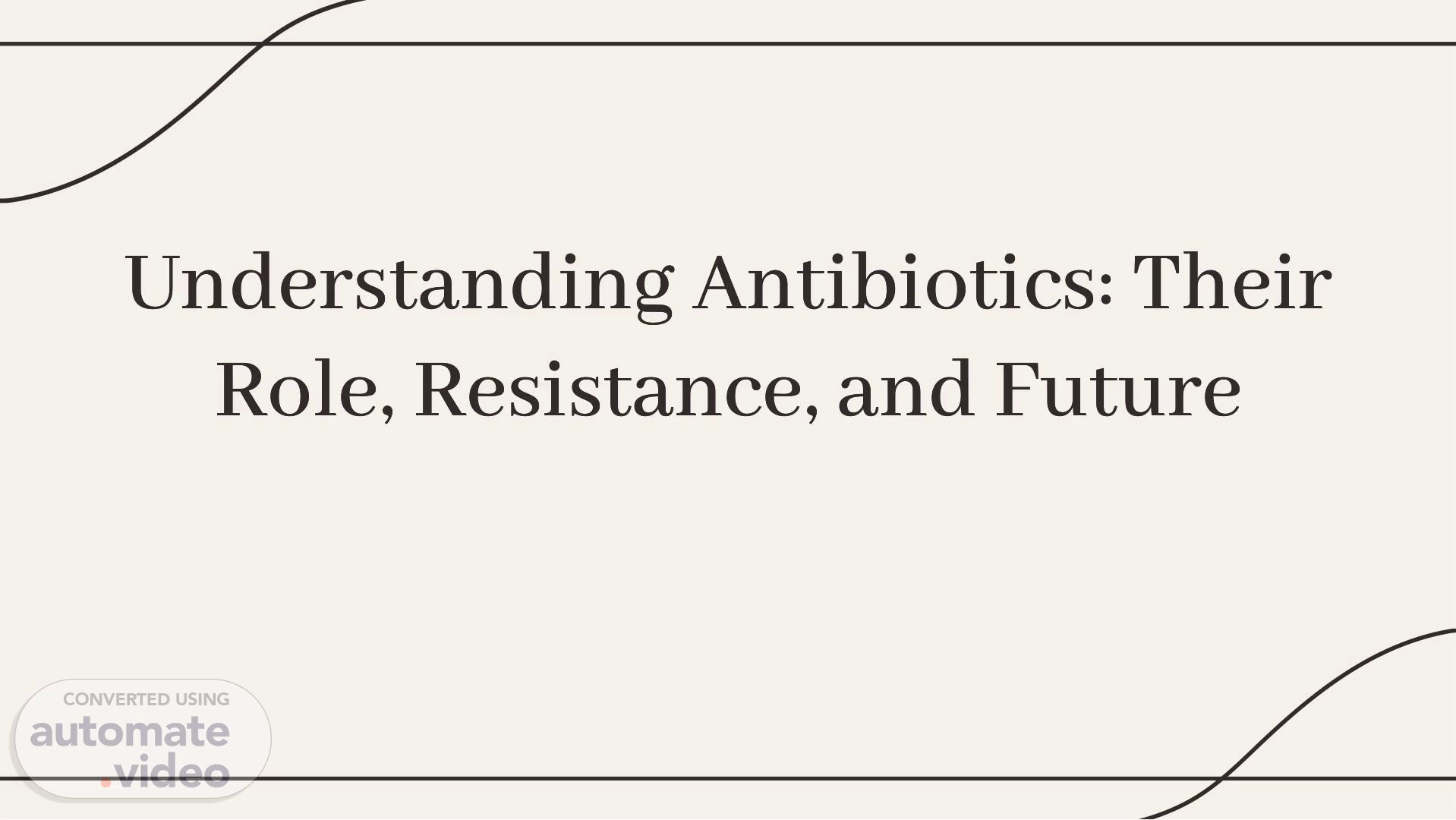
slidesgo-understanding-antibiotics-their-role-resi_240921_213430
Scene 1 (0s)
Understanding Antibiotics: Their Role, Resistance, and Future Understanding Antibiotics: Their Role, Resistance, and Future.
Scene 2 (8s)
Antibiotics are powerful medications that fight bacterial infections. They work by either killing bacteria or inhibiting their growth. Understanding their role is crucial for effective healthcare and combating resistance. This presentation will explore their importance, the challenge of resistance, and future perspectives. Antibiotics are powerful medications that fight bacterial infections. They work by either killing bacteria or inhibiting their growth. Understanding their role is crucial for effective healthcare and combating resistance. This presentation will explore their importance, the challenge of resistance, and future perspectives..
Scene 3 (32s)
Antibiotics are substances that combat bacterial infections. They can be derived from natural sources or synthesized in laboratories. Their primary function is to target specific bacteria without harming human cells, making them essential in modern medicine. Antibiotics are substances that combat bacterial infections. They can be derived from natural sources or synthesized in laboratories. Their primary function is to target specific bacteria without harming human cells, making them essential in modern medicine. What Are Antibiotics? What Are Antibiotics?.
Scene 4 (51s)
Types of Antibiotics Types of Antibiotics There are two main categories of antibiotics: bactericidal (which kill bacteria) and bacteriostatic (which inhibit bacterial growth). Each type works differently and is used based on the type of infection and the bacteria involved. There are two main categories of antibiotics: bactericidal (which kill bacteria) and bacteriostatic (which inhibit bacterial growth). Each type works differently and is used based on the type of infection and the bacteria involved..
Scene 5 (1m 10s)
How Antibiotics Work How Antibiotics Work Antibiotics disrupt essential processes in bacteria, such as cell wall synthesis, protein production, and DNA replication. By targeting these processes, antibiotics effectively eliminate or control bacterial infections, allowing the immune system to recover. Antibiotics disrupt essential processes in bacteria, such as cell wall synthesis, protein production, and DNA replication. By targeting these processes, antibiotics effectively eliminate or control bacterial infections, allowing the immune system to recover..
Scene 6 (1m 30s)
Antibiotic resistance occurs when bacteria evolve and become immune to the effects of antibiotics. This growing problem is fueled by overuse and misuse of these medications, leading to treatment failures and increased healthcare costs. Antibiotic resistance occurs when bacteria evolve and become immune to the effects of antibiotics. This growing problem is fueled by overuse and misuse of these medications, leading to treatment failures and increased healthcare costs. The Rise of Resistance The Rise of Resistance.
Scene 7 (1m 50s)
Causes of Antibiotic Resistance Causes of Antibiotic Resistance Key factors contributing to antibiotic resistance include overprescription, incomplete courses of treatment, and the use of antibiotics in agriculture. These practices create an environment where resistant bacteria can thrive and multiply. Key factors contributing to antibiotic resistance include overprescription, incomplete courses of treatment, and the use of antibiotics in agriculture. These practices create an environment where resistant bacteria can thrive and multiply..
Scene 8 (2m 9s)
Antibiotic resistance poses a significant threat to public health. It can lead to longer hospital stays, higher medical costs, and increased mortality rates. Addressing this issue requires a collective effort from healthcare professionals and the public. Antibiotic resistance poses a significant threat to public health. It can lead to longer hospital stays, higher medical costs, and increased mortality rates. Addressing this issue requires a collective effort from healthcare professionals and the public..
Scene 9 (2m 29s)
Preventing Antibiotic Resistance Preventing Antibiotic Resistance Preventing antibiotic resistance involves responsible prescribing practices, patient education, and infection control measures. Awareness campaigns and guidelines can help ensure antibiotics are used appropriately to preserve their effectiveness. Preventing antibiotic resistance involves responsible prescribing practices, patient education, and infection control measures. Awareness campaigns and guidelines can help ensure antibiotics are used appropriately to preserve their effectiveness..
Scene 10 (2m 46s)
The future of antibiotics relies on innovation and research into new classes of antibiotics and alternative therapies. Developing vaccines and better diagnostic tools will also play a critical role in combating resistance and improving patient outcomes. The future of antibiotics relies on innovation and research into new classes of antibiotics and alternative therapies. Developing vaccines and better diagnostic tools will also play a critical role in combating resistance and improving patient outcomes. Future of Antibiotics Future of Antibiotics.
Scene 11 (3m 5s)
Vaccines can reduce the need for antibiotics by preventing bacterial infections in the first place. By immunizing populations, we can decrease the incidence of infections, leading to lower antibiotic consumption and reduced resistance. Vaccines can reduce the need for antibiotics by preventing bacterial infections in the first place. By immunizing populations, we can decrease the incidence of infections, leading to lower antibiotic consumption and reduced resistance. Role of Vaccines Role of Vaccines.
Scene 12 (3m 23s)
International organizations are working to combat antibiotic resistance through surveillance, research funding, and promoting best practices in antibiotic use. Collaboration across borders is essential to effectively address this global health challenge. International organizations are working to combat antibiotic resistance through surveillance, research funding, and promoting best practices in antibiotic use. Collaboration across borders is essential to effectively address this global health challenge..
Scene 13 (3m 42s)
Understanding antibiotics and their role is vital for public health. Combating antibiotic resistance requires collective action from individuals, healthcare providers, and policymakers. Together, we can ensure the effectiveness of antibiotics for future generations. Understanding antibiotics and their role is vital for public health. Combating antibiotic resistance requires collective action from individuals, healthcare providers, and policymakers. Together, we can ensure the effectiveness of antibiotics for future generations. Conclusion: A Call to Action Conclusion: A Call to Action.
Scene 14 (4m 2s)
Thanks! Thanks! Do you have any questions? youremail@email.com +91 620 421 838 www.yourwebsite.com @yourusername Do you have any questions? youremail@email.com +91 620 421 838 www.yourwebsite.com @yourusername.